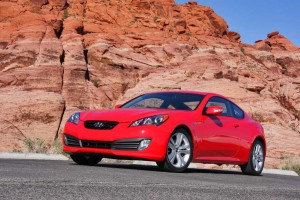
Turning heads and leaving tire tracks, the Genesis Coupe should help redefine the Korean brand.
If you’re a comedian, there are some things that automatically ensure a laugh. You can slip on a banana peel or take a pie in the face. You usually only have to mention New Jersey – and before you Joisey boys write me hate letters, know that I grew up off Exit 117 – or you can say the word “Hyundai.”
Since its American debut, two decades ago, the Korean carmaker has been the butt of Leno’s late night jokes, and not taken very seriously by automotive aficionados. That was well-deserved in the days of the original Hyundai Pony, but not anymore. If you hadn’t heard, the automaker’s first luxury car, the Genesis sedan, was named North American Car of the Year by a panel of 50 U.S. and Canadian autowriters, early this year. (I’m one of those judges.)
Now comes the second car to bear the Genesis badge, in this case a striking blend of styling, power and sporty handling dubbed the Genesis Coupe. Its debut should have the competition seriously concerned. And that’s no joke.
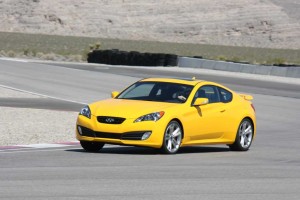
The Genesis Coupe's rear-drive powertrain provides an unexpectedly exhilarating ride, on-track or off.
We flew out to Las Vegas to put the 2010 Hyundai Genesis Coupe through its paces, spending a long day both on the road and on a track. What we discovered was a slick little 2-door that’s affordable, but not in the cheap-and-cheerful way most people still think of Hyundai products. Even at a base price of $22,000, the ’10 coupe is a surprisingly well-equipped offering. But what’s really a pleasant surprise is the way this little brother to the luxurious Genesis sedan commends itself on the road.
First, we need point out that this is not simply a 2-door version of the sedan, which went on sale last year. The basic numbers show that the coupe’s wheelbase, at 111.0 inches, is nearly five inches shorter, while it’s more than a foot shorter, nose-to-tail, at 182.3 inches. It’s also about four inches lower, at 54.5 inches, and in a reasonably apple-to-apples comparison, the 3397 pound, 3.8-liter V-6 coupe is 500 pounds lighter than the larger, more luxurious 4-door. (With the turbo 2.0-liter package, the coupe’s weight drops to 3294 pounds, making it one of the lighter offerings in its segment.)
But you don’t need the statistics to tell the difference. Where the design of the sedan is more traditional – and more derivative, clearly influenced by the classic Mercedes-Benz look – there’s a bit of the bad boy in the styling of the Genesis Coupe. “We didn’t wants to do a 2-door version because we didn’t think we’d sell many,” says John Krafcik, CEO of Hyundai Motor America, who insists the coupe is, “our most passionate, most emotional car ever.”
Watching the Genesis Coupe come up in your rearview mirror, you’ll discover the Hyundai badge mounted in a small, honeycomb black grille. There’s a larger, more aggressive air intake under the bumper, surrounded by chrome accent strips and integrated foglamps. From the side, Hyundai designers developed a bit of a coke bottle shape, with an accent line rising from nose to the slightly flared rear fenders. One of the most noticeable features is the reverse kick of the small rear side windows, a detail that generated a lot of excitement when the original concept coupe first appeared, a few years ago.
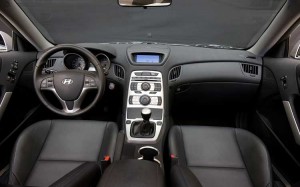
A generally upscale interior is hurt by cheap touches, such as the high-mounted display screen.
The large rear window provides unexpectedly good visibility for a coupe, and despite the integrated rear spoiler. The taillights, like the lamps up front, are wraparound, giving the Genesis Coupe a more elegant, yet spirited feel. The twin, asymmetric chromed exhaust tips provide the finishing touch. The good news is that, for the most part, the eye candy on this car is also quite functional.
With its short overhangs and relatively long hood, the second entry into the Genesis line has the classic, overall dimensions of a sporty, rear-wheel-drive sedan. No “sporty” front-drive offering for Hyundai, a good thing if you’re claiming cars like the BMW 335i and Infiniti G37 Coupe among your competitive target set.
Inside, the styling is equally crisp and sporty, with a cockpit-style layout that nicely compliments the exterior and generally matches the Genesis Coupe’s sporty aspirations. Visibility is great, particularly for a coupe. Even the base car is well executed, while the trim on the top-line 3.8 Grand Tourer is especially well done – gaining such niceties as heated leather seats and an audiophile-level Infinity 360-watt, 10-speaker sound system. (The GT also adds integrated foglamps, rear parking sensors, heated side mirrors, with integrated turn signals, xenon headlamps, keyless remote and other niceties.)
Sure, there are a few nits to pick, particularly the lack of a telescoping steering wheel. (It does tilt, but you may have to do some maneuvers to find a reasonable seating position if you’re particularly long-legged.) The blue odometer readout is difficult to read, even in the best lighting conditions, never mind on a bright day in the desert. And the information center, at the top of the center stack, is almost a throw-back to Hyundai’s bad old days, poorly grained and not very attractive, especially compared to another display, lower on the console.
The front seats get mixed reviews, we find, talking to our media colleagues. Some folks, ourselves included, seem to love the supportive design. Even after a long drive out to the track, a few hours flogging around a twisting race track, and then the drive home, I personally found little to complain about. Others contend the seats are a bit too hard on the body. You’ll find no one defending the rear seats, however. They might be good for young children, or extra luggage, but not much more.
There are a variety of base, sporty and grand touring models in the Genesis Coupe hierarchy. We’d run out of space talking about them all, so let’s focus on key components and models.
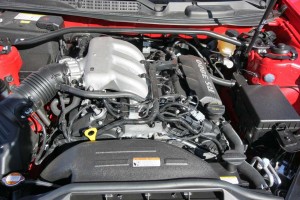
The Coupe is offered in a variety of flavors -- with two engine options and the choice of a 6-speed stick or 5-speed automatic.
First, there are two powertrain packages: the base 2.0-liter I-4, with its intercooled turbo helping pump out a solid 210 horsepower and 223 pound-feet of torque. Power comes on quick, with only the most moderate amount of turbo lag, and none of the torque steer you experience in front-drive competitors.
The bigger, 3.8-liter V-6 makes a hefty 306 hp and 266 lb-ft. That’s 16 more horsepower and 2 pound-feet than the six-banger generates in the Genesis sedan, incidentally, and you’ll appreciate the added numbers when you’re pushing the V-6 Coupe to its limits. It gets there surprisingly quickly.
Each engine package has its own, distinct personality. We expect to see the affordable 2.0T grabbed up by the young tuner crowd, and Hyundai officials expect to see a significant array of aftermarket accessories, including performance-boosting chips and the like. They caution that some of these could void the car’s warranty. But in a distinct break from some of their import competitors, the Korean maker won’t penalize an owner from taking the car out on the track. Quite the opposite. Hyundai is all but encouraging it.
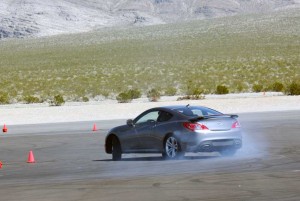
The Coupe's rear-drive provides an unexpected degree of control yet a comfortable on-road feel.
With a manual gearbox, you’ll hit 60 in about 7 seconds on the 2.0T. The 3.8-liter powertrain turns the best times, clocking 0 to 60 in 5.5 seconds. It’s not quite up to the Infiniti G37, at least on the straights, but the Genesis Coupe will likely make up time in the corners, especially if you’re a good enough driver to let the rear end hang out in those tight turns. We had a chance to drift, during our day at the track, and the predictability and control the coupe boasts is almost uncanny. On a traditional course, it proved near impossible to have the back end lose grip short of making the most boneheaded maneuvers.
What’s particularly appealing is that there’s no real trade-off, at least with the current models, in terms of on-highway handling and road feel. Credit the carefully tuned suspension, which relies on dual McPherson struts, up-front, and an independent 5-link rear. That’ll likely change when Hyundai delivers the eagerly-awaited Genesis Coupe Spec-R, a stripped-down, street-legal racer, which will go for an impressive $23,750.
If we have one complaint when it comes to the powertrain side, it’s the 6-speed manual. The 5-speed automatic is a reasonable good package, though we’d like to see a six. The stick definitely needs improvement, as even a couple of Hyundai folk acknowledged privately. It’s a bit sloppy, the clutch isn’t the fastest, and you can inadvertently shift into reverse, rather than first, thanks to a weak spring lock-out. An opportunity for the aftermarket?
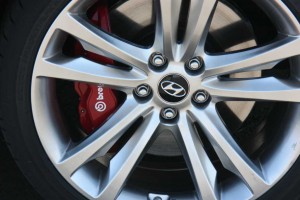
Horsepower is but one measure of performance. The Coupe includes Brembo brakes at each corner.
In terms of safety gear, Hyundai has been adding technology rapidly, seeing it as another way to upgrade its image. The 2010 Genesis Coupe boasts six airbags, ABS, Electronic Brake-Force Distribution, Brake Assist, Traction Control and Electronic Stability Program, as well as active head restraints and a tire pressure monitoring system. Oh, and there’s a 1-touch Track Defeat Mode for the stability control that cuts the system out in all but the most severe situations of lost control.
With the top-line track models, incidentally, you’ll get a set of bright red 4-piston Brembo brakes. They’re absolutely up to the task of scrubbing off speed in a hurry on a track.
In terms of fuel economy, Hyundai took pains to point out that you’ll get 30 mpg on the highway, with the Genesis Coupe 2.0T, and 21 in the EPA’s City cycle. For the 3.8, count on 17 and 26, at least according to the EPA. But, as they say, mileage may vary – especially if you expect to push the 2-door to its limits.
It’s been something of a surprise to see just how quickly Hyundai has evolved, as a brand. There was a time, early on, when we admittedly took the keys for review cars with great reluctance. By the time the first-generation Santa Fe SUV debuted, we were starting to say, “not a bad vehicle – for a Hyundai.” The Genesis sedan didn’t require any such excuses, as the car-of-the-year designation underscored. Now comes the Genesis Coupe, which effectively replaces the mediocre Tiburon.
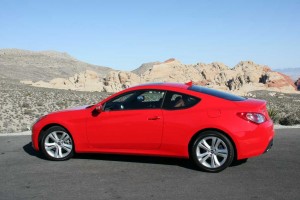
The Coupe should find an audience among tuner fans, and those looking for an affordable sporty car .
Sure, with prices ranging from the low $20s to the low $30,000-range, the 2010 Hyundai Genesis Coupe is still a surprisingly affordable product, but this time, that’s not an excuse for all sorts of cut corners. The compromises are minimal and, if anything, the car delivers the sort of features, handling, performance and package we’d expect from a significantly more expensive automobile. Don’t be surprised to start seeing a lot of them on the road – and on the track.

test drove the grand touring V6 and it was fantastic. Punched it on the highway and was at 100 mph lickety split – very, very, very nice ride. Smooth, great handling.
Great looking too. Recommend highly. Good value.
This article has a factual error. The author complains about the transmission choices, and wishes a 6 speed automatic were available – When it is.
Colin: i’m glad you mentioned their ommission of the fact that a six-speed ZF automatic is available with all of the the 3.8 models, including the track version.
So far, Motor Trend is the only auto magazine to have tested a 3.8 Track with the 6-sp auto, and it is every bit as fast as the manual, gets better highway MPG, and doesn’t have that torque-robbing drop in revs when upshifting that the manual has.
The upshifts in the auto are rev-matched, but not the downshifts…probably for the same self-preservation reason.
The ZF auto is not as good as the ZF double-clutch, autoshift manual in the Lancer Evolution, but that “pocket rocket” will set your pocket back $45k, lacks the amenities of the Genesis Coupe, has a driver’s seat that will make you a permanent soprano if you happen to sit on the edge of it, and one that will kill your spine if you use it on a daily commute.
The 2.0 version offers a 5-speed auto made by Aisan and it might be the same unit as what is used in the 2009 Sonata.